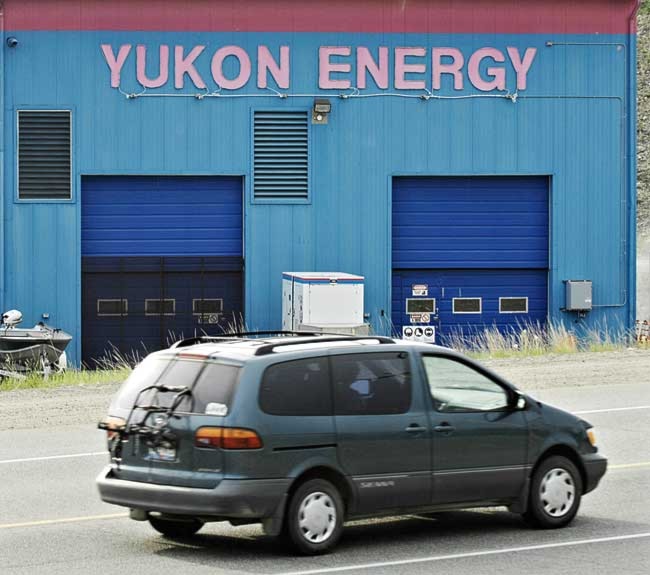To meet the demands of an expanding, energy-hungry population, and to meet the needs of the territory’s mining industry, Yukon Energy needs to find ways to generate more electricity.
Currently, the utility has the capacity to generate 400 gigawatt hours of renewable electricity, but more than 200 gigawatt hours could be needed in the next three years, according to the utility’s recent draft of its 20-year resource plan.
However, the territory is not in any risk of running out of electricity, said Janet Patterson, spokesperson for Yukon Energy.
“We aren’t going to be sitting in the dark,” she said. “It’s just a matter of how much diesel do we have to burn, because we can always turn on another diesel, it’s just that’s not what we’d prefer to do.”
Yukon Energy would rather make up the shortfall with renewable energy.
It has a number of projects under consideration.
The utility is looking at the potential of squeezing more power out of its existing hydro plants.
That could mean holding water back for longer periods of time in the Southern lakes, diverting more to feed the turbines at the Aishihik plant, or drawing down a bit more water on Mayo Lake.
It’s also doing an engineering study to look at the potential of putting a wood biomass plant in Haines Junction and finishing up a wind monitoring project near Stewart Crossing.
A potential hydro project in Hoole Canyon, in central Yukon, is also under consideration.
But all of those projects are going to take time to complete, and that means the territory will be left burning diesel to make up any shortfalls.
In the interim, Yukon Energy is investigating the possibility of constructing a liquefied natural gas plant in the territory.
Natural gas is cheaper and cleaner burning than diesel, but it’s not “clean,” said Patterson.
The big advantage is that it’s flexible – it can be easily scaled up or down to meet demand.
Flexibility is an important consideration because, “We’re never quite sure what the demand is going to be,” said Patterson.
Because the Yukon is not connected to any other electricity grid, finding the right mix of generating options is a delicate balance.
“If we over-build, we have no way of selling it to anyone else, and Yukoners are stuck with a whole bill,” said Patterson. “We need to be able to find a way to reduce the risk for Yukoners, to build enough, but not build too much.”
Connecting to the grid in B.C. could be an option, although with a price tag in excess of $1 billion, it’s an expensive proposition.
Yukon Energy is also in talks with the Alaskan government about the possibility of running a transmission line to Skagway.
“The borough would like to have a hydro project there so they can service the cruise ships that come in the summertime,” said Patterson. “Right now they’re on diesel, and they burn a heck of a lot of diesel.”
Inversely, the Yukon has electricity to spare in the summer, but needs to burn diesel in the winter to meet demand.
Running a transmission line that way could also create some opportunity for small-scale hydro projects along the route that wouldn’t otherwise be feasible, said Patterson. But it’s too soon to tell how much it will cost.
Yukon Energy isn’t just looking at ways to generate more electricity, but also at ways to save it.
The utility hopes to have an energy conservation program ready to go by 2013.
“The more energy we are able to save, that’s less energy we have to find, or build, so that’s crucial to anything else we do,” said Patterson.
Yukon Energy is also looking to tap into Yukoners as a resource.
The last time the company updated its 20-year plan in 2006, it was done in a much more conventional way, said Patterson.
“We sat in a room, a group of us, and talked among ourselves and came up with what we thought was the best approach to take,” she said.
This time, though, they included the public in that discussion.
In addition to a three-day energy charrette, the utility held a number of workshops and meetings throughout the Yukon to explore all of its potential energy solutions.
“I guess since (2006) the thinking has changed and we realized that we don’t have all the answers,” said Patterson. “We thought that if we got as many people as possible, from as many different perspectives as possible in a room together and had a big, sort of broad discussion about where we should be heading, that the end product would be a better product; and it was.”
One thing that came out of recent discussions has been the prospect of doing wind projects on a smaller scale to improve the economic potential.
“That’s something that we want to look into further,” said Patterson.
The discussion is ongoing.
This latest update to Yukon Energy’s 20-year plan is just the first draft. Before the company submits it to the Yukon Utilities board for consideration, it’s seeking input from the public.
Meetings will be held in Haines Junction Aug. 13, followed by one in Whitehorse Aug. 14, Mayo Aug. 29 and Dawson City Aug. 30, with more to follow.
Even if people can’t make it out to one of the meetings, they can write in, call or just drop by in person, said Patterson.
“We are very sincere in wanting people’s feedback on this,” she said.
Contact Josh Kerr at joshk@yukon-news.com
